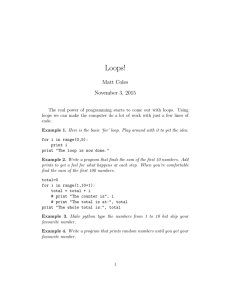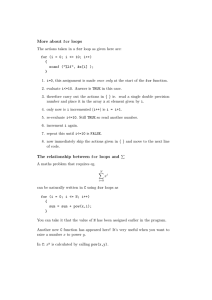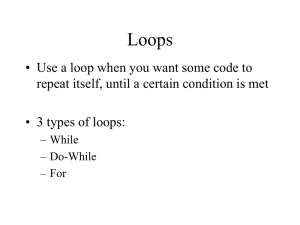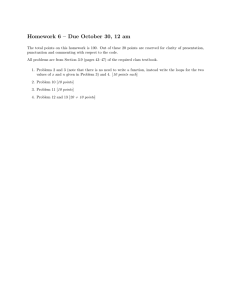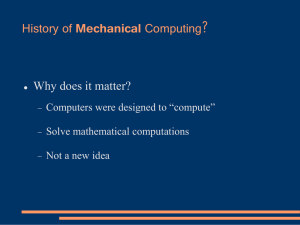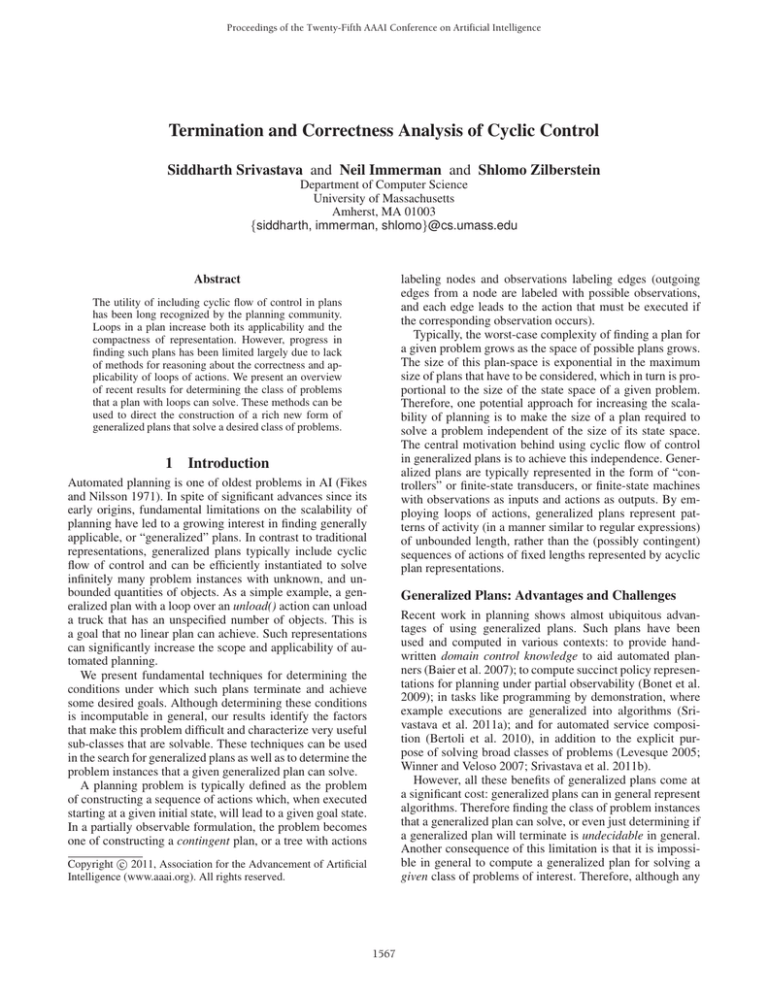
Proceedings of the Twenty-Fifth AAAI Conference on Artificial Intelligence
Termination and Correctness Analysis of Cyclic Control
Siddharth Srivastava and Neil Immerman and Shlomo Zilberstein
Department of Computer Science
University of Massachusetts
Amherst, MA 01003
{siddharth, immerman, shlomo}@cs.umass.edu
labeling nodes and observations labeling edges (outgoing
edges from a node are labeled with possible observations,
and each edge leads to the action that must be executed if
the corresponding observation occurs).
Typically, the worst-case complexity of finding a plan for
a given problem grows as the space of possible plans grows.
The size of this plan-space is exponential in the maximum
size of plans that have to be considered, which in turn is proportional to the size of the state space of a given problem.
Therefore, one potential approach for increasing the scalability of planning is to make the size of a plan required to
solve a problem independent of the size of its state space.
The central motivation behind using cyclic flow of control
in generalized plans is to achieve this independence. Generalized plans are typically represented in the form of “controllers” or finite-state transducers, or finite-state machines
with observations as inputs and actions as outputs. By employing loops of actions, generalized plans represent patterns of activity (in a manner similar to regular expressions)
of unbounded length, rather than the (possibly contingent)
sequences of actions of fixed lengths represented by acyclic
plan representations.
Abstract
The utility of including cyclic flow of control in plans
has been long recognized by the planning community.
Loops in a plan increase both its applicability and the
compactness of representation. However, progress in
finding such plans has been limited largely due to lack
of methods for reasoning about the correctness and applicability of loops of actions. We present an overview
of recent results for determining the class of problems
that a plan with loops can solve. These methods can be
used to direct the construction of a rich new form of
generalized plans that solve a desired class of problems.
1
Introduction
Automated planning is one of oldest problems in AI (Fikes
and Nilsson 1971). In spite of significant advances since its
early origins, fundamental limitations on the scalability of
planning have led to a growing interest in finding generally
applicable, or “generalized” plans. In contrast to traditional
representations, generalized plans typically include cyclic
flow of control and can be efficiently instantiated to solve
infinitely many problem instances with unknown, and unbounded quantities of objects. As a simple example, a generalized plan with a loop over an unload() action can unload
a truck that has an unspecified number of objects. This is
a goal that no linear plan can achieve. Such representations
can significantly increase the scope and applicability of automated planning.
We present fundamental techniques for determining the
conditions under which such plans terminate and achieve
some desired goals. Although determining these conditions
is incomputable in general, our results identify the factors
that make this problem difficult and characterize very useful
sub-classes that are solvable. These techniques can be used
in the search for generalized plans as well as to determine the
problem instances that a given generalized plan can solve.
A planning problem is typically defined as the problem
of constructing a sequence of actions which, when executed
starting at a given initial state, will lead to a given goal state.
In a partially observable formulation, the problem becomes
one of constructing a contingent plan, or a tree with actions
Generalized Plans: Advantages and Challenges
Recent work in planning shows almost ubiquitous advantages of using generalized plans. Such plans have been
used and computed in various contexts: to provide handwritten domain control knowledge to aid automated planners (Baier et al. 2007); to compute succinct policy representations for planning under partial observability (Bonet et al.
2009); in tasks like programming by demonstration, where
example executions are generalized into algorithms (Srivastava et al. 2011a); and for automated service composition (Bertoli et al. 2010), in addition to the explicit purpose of solving broad classes of problems (Levesque 2005;
Winner and Veloso 2007; Srivastava et al. 2011b).
However, all these benefits of generalized plans come at
a significant cost: generalized plans can in general represent
algorithms. Therefore finding the class of problem instances
that a generalized plan can solve, or even just determining if
a generalized plan will terminate is undecidable in general.
Another consequence of this limitation is that it is impossible in general to compute a generalized plan for solving a
given class of problems of interest. Therefore, although any
c 2011, Association for the Advancement of Artificial
Copyright Intelligence (www.aaai.org). All rights reserved.
1567
S1
plan with a cyclic flow of control that terminates will solve
some class of problem instances (a pattern of activity naturally corresponds to the pattern of problem instances that
it solves), it is impossible in general to find such plans for
solving an arbitrary class of problems.
This is a severe limitation in finding generalized plans.
Not surprisingly, very few approaches assert correctness of
the generalized plans they produce, or even compute generalized plans for solving a given class of problems (Hu and
Levesque 2010; Bertoli et al. 2010; Srivastava et al. 2011b;
2011a). In this paper we present a general method for determining the conditions under which plans with loops will
terminate at a particular state (Srivastava et al. 2010).
We initially assume that planning actions come from a
simple, but powerful, class of action operators, which can
only increment or decrement a finite set of registers by unit
amounts. Although this class of actions appears to be too
primitive for planning domains, plans with loops for many
interesting planning problems can be automatically translated into plans with such actions (Srivastava et al. 2011b).
The class of actions considered in this work is captured
by abacus programs—an abstract computational model as
powerful as Turing machines. The halting problem for abacus programs is thus undecidable. In other words, finding closed-form applicability conditions, or preconditions
for plans with loops of just the primitive abacus actions
is undecidable. Despite this negative result, we show that
closed-form preconditions can be found for certain structured classes of abacus programs, and demonstrate that such
structures are sufficient to solve interesting planning problems. In addition to determining the scope of applicability of
existing plans, these methods can also be used during plan
computation for identifying useful loops of actions.
2
{r1}
{r2}
>0
=0
S2
S3
Figure 1: A simple abacus machine for the program: while
(r1 > 0) { r1 − −;r2 + +}
node is reached. An abacus program terminates iff its execution reaches the halt node. The set of final register values
in this case is called the output of the abacus program.
Abacus programs are equivalent to Minsky Machines
(Minsky 1967), which are as powerful as Turing machines
and thus have an undecidable halting problem:
Fact 1. The problem of determining the set of initial register
values for which an abacus program will reach the halt node
is undecidable.
Nevertheless, we identified a general class of abacus programs for which the halting problem is decidable.
As discussed in the introduction, our approach for determining the utility and applicability conditions of loops of
planning actions is to view them as abacus programs with
the same loop structure. Maintaining the loop structure while
doing this translation is important as it will allow us to selectively construct plans with the structures that we know
can be handled. However, the abacus program framework is
restrictive from this point of view: it does not include nondeterministic actions. In planning on the other hand, nondeterministic sensing actions are common and we need a
way to translate them into the abacus framework effectively,
without changing the loop structure. For this purpose, we
extend the abacus program framework with the following
non-deterministic action, in the representation of Def. 1:
Definition 2. (Non-deterministic Abacus Programs) Nondeterministic abacus programs are abacus programs whose
set of actions, Act includes, in addition to the Inc and Dec
actions, non-deterministic actions of the form:
• NSet(r, s1 , s2 ): set r to 0 and goto s1 ∈ S or set r to 1
and goto s2 ∈ S.
where S is the set of states of the abacus program and r is a
register that is not used by deterministic actions.
A non-deterministic action thus has two outgoing edges in
the graph representation, corresponding to the two possible
values it can assign to a register. Either branch may be taken
during execution. Although the original formulation of abacus programs is sufficient to capture any computation, these
actions will allow us to conveniently treat a powerful class of
nested loops (encountered in partially observable planning)
as a set of independent simple loops.
Abacus Programs
Abacus programs are finite automata whose states are labeled with actions that increment or decrement a fixed set of
registers (Lambek 1961). Formally,
Definition 1. (Abacus Programs) An abacus program
R, S, s0 , sh , consists of a finite set of registers R, a finite set of states S with special initial and halting states
s0 , sh ∈ S and a labeling function : S \ {sh } → Act.
The set of actions, Act, consists of actions of the form:
• Inc(r, s): increment r ∈ R; goto s ∈ S, and
• Dec(r, s1 , s2 ): if r = 0 goto s1 ∈ S else decrement r and
goto s2 ∈ S
We represent abacus programs as bipartite graphs with
edges from nodes representing states to nodes representing
actions and vice-versa. State-nodes have at most one outgoing edge and action-nodes have at most two outgoing edges;
the two edges out of a decrement action are labeled = 0 and
> 0 respectively (see Fig. 1). A more succinct representation that does not use state-nodes is also possible, but we
use state-nodes to improve clarity and maintain a correspondence with planning scenarios.
Given an initial valuation of its registers, the execution of
an abacus program starts at s0 . At every step, an action is
executed, the corresponding register is updated, and a new
3
Computing Applicability Conditions
We begin with the simplest class of abacus programs with
loops:
Definition 3. (Simple-Loop Abacus Programs) A simple
loop in a graph is a strongly connected component consisting of exactly one cycle. A simple-loop abacus program is
one all of whose non-trivial strongly connected components
are simple loops.
1568
S1
S1
a6
S6
an
a1
a5
S5
a3
a6
S6
S2
a2
S’4
S5
a3
a4
Se
S4
a1
a5
S3
register values, variables representing the number of iterations of each loop, and constants. These conditions determine when a given, initial valuation of registers can lead to
a desired state with a desired set of register values. In order
to state this result, we make a final definition that determines
the accuracy of these conditions:
Chosen start node
S’6
a2
a4
Se
S2
an
S3
Definition 7. (Order Independence) A simple loop with
shortcuts is order independent if for every initial valuation
of the registers at Sstart , the set of register-values possible
at Sstart after any number of iterations does not depend on
the order in which those iterations are taken.
S4
Figure 2: A simple loop with (right) and without (left) shortcuts
We refer to non-trivial strongly connected components
that are not simple loops as complex loops. In particular, we
will be interested in a special class of complex loops, i.e.,
those obtained by adding “shortcuts” in a simple loop:
Our main result can be summarized as follows:
Theorem 1. Let Π be an abacus program, all of whose
strongly connected components are simple loops with monotone shortcuts. Let S be any node in the program, and F̄ a
vector of register values. We can then compute a disjunction
of linear constraints, (Π, S, F̄ ), which constitute sufficient
conditions on the initial register values for reaching S with
the register values F̄ . If all simple loops with shortcuts in
Π are order independent, then the conditions (Π, S, F̄ ) are
also necessary.
Definition 4. (Simple loop with shortcuts) A simple loop
with shortcuts is a strongly connected component C which
includes a node S0 , designated the start node, such that removing S0 makes C acyclic.
Intuitively, a simple loop with shortcuts consists of a simple loop with all elements, starting at the start node, in increasing linear order. For any pair of nodes along the loop, a
preceding b, a shortcut from a to b may be added; different
shortcuts may overlap as long as this does not create cycles.
(e.g., node S2 can be designated the start node in Fig. 2).
Simple loops with shortcuts form a very general class of
complex loops: graph theoretically, this is exactly the class
of strongly connected components with cycle rank (Eggan
1963) 1. Many control flows that are typically understood as
“nested” loops in programming can be represented as simple
loops with shortcuts. The advantage of this class of loops is
that we can decompose them into simple loops; in the definition below, a cycle has no repeated nodes other than the
start and end nodes.
This result gives us the applicability conditions of plans
with monotone, simple loops with shortcuts; the accuracy of
these conditions depends on the notion of order-dependence.
4
Applications and Conclusion
The methods discussed above apply very broadly, whenever
the effects of planning actions can be represented using increment or decrement operations on some counters. These
counters could measure, for instance, changes in the number
of objects satisfying some relevant conditions.
We have recently presented an approach for extracting this
information from plans in certain domains (Srivastava et al.
2011b). Fig. 3 shows an example plan for the recycling problem, where a recycling agent needs to visit a set of bins and
from each bin, collect paper and glass objects into containers for each kind. Both containers have limited capacities.
Both of the collect actions in Fig. 3 decrease the capacity of
these containers by one and the edge labeled empty(b) is followed when bin b is empty (this edge represents a decrement
in the number of non-empty bins). Our methods can easily
prove that such plans terminate, and that their preconditions
assure, for example, that container capacities are larger than
the number of objects that need to be recycled.
We have already used these methods successfully to generalize sample classical plans (Srivastava et al. 2011b) and
to develop a hybrid approach for constructing generalized
plans without any input examples (Srivastava et al. 2011a).
The hybrid approach works by incrementally (a) creating an
instance of the currently unsolved class of problems, (b) using a classical planner to get a plan for this instance, (c) generalizing this plan, and finally, (d) merging this generalization with the existing generalized plan, which is originally
empty. In this process, we use the approach presented here
to create safe and useful loops in steps (c) and (d), and also
to identify valid unsolved problem instances.
Definition 5. (Loop Decomposition) Let K be a graph in the
form of a simple loop with shortcuts with start node S0 . The
loop decomposition of K is defined as the set of all cycles of
K beginning with S0 .
In the worst case, the size of this decomposition can be
exponential in the number of shortcuts. By Def. 4, we know
that in a simple loop with shortcuts every cycle must contain the start node. Thus, the execution of a simple loop with
shortcuts can be viewed as a sequence of executions of the
simple loops in its decomposition. For instance, we can view
the loop with shortcuts in Fig. 2 as consisting of 3 different simple loops. The order of execution of these loops, and
whether a particular loop will be executed at all, will depend
on the value of registers in states S3 , S4 and S5 .
We consider a restriction of simple loops with shortcuts in
which the preconditions for reaching any state in an abacus
program can be determined:
Definition 6. (Monotone simple loops with shortcuts) A
simple loop with shortcuts in an abacus program is monotone iff the sign of the net change, if any, in a register’s value
is the same for every simple loop in its decomposition.
Our main contribution is a method for computing a set
of linear constraints between variables representing initial
1569
mv(R, b: −empty(b))
#(−empty) = 0
thus pave the way for accelerated research in these areas.
Stop
empty(b)
PickObj(o: in(o,b))
Acknowledgments
senseType(o)
paper
collect(o,c: forPaper(c)& −full(c))
#(forPaper, −full)>0
Support for this work was provided in part by the National Science Foundation under grants IIS-0915071, CCF0541018, and CCF-0830174.
glass
collect(o,c: forGlass(c)& −full(c))
#(forGlass, −full)>0
Figure 3: Solution plan for the recycling problem
References
Our methods can also be applied in various other settings.
For example, the problem of programming by demonstration (PBD) is to construct a program by generalizing input
sequences of operations. One of the biggest challenges in
PBD is to generalize the demonstrated sequences into correct loops of actions and establish their termination conditions. Existing approaches (e.g. (Lau et al. 2003)) often require user-annotations to identify loop iterations and associate confidence scores with the resulting generalizations.
Our methods provide two distinct advantages: (a) they can
rank different possible generalizations on the basis of semantic measures such as their domain coverage, or the fraction of problem instances of interest that they would solve,
and (b) they can prune the space of possible generalizations
by removing loops that are provably non-terminating.
The results we present are also relevant to workflow inference (Eker et al. 2009; Yaman and Oates 2007), which
is similar to PBD, but emphasizes learning loops of dataprocessing actions from example traces, and automated service composition, where functionalities offerred by different
software or web services need to be integrated to achieve
new composite services. While various approaches exist
to construct linear compositions of services that may internally include cyclic control flow (Bertoli et al. 2010;
Narayanan and McIlraith 2002), our approach could provide methods for constructing more powerful, cyclic compositions. For instance, given a website that lists restaurant cuisines, ratings, and addresses along with a publictransportation website, a graduate student attending a conference may want to find all budget restaurants that serve a
particular cuisine with easy access from both the conference
venue and his or her hotel. A composed service for achieving these results would have to extract an unknown number
of qualifying restaurants, and use the transport computation
service for each, in a loop.
Finally, our approach is also applicable to program verification and synthesis. In this area, our approach is related
to methods for proving termination of programs. In particular, the T ERMINATOR system (Cook et al. 2006) uses an
abstracted formulation of action operators to construct linear ranking functions, or functions of the loop variables that
are bounded above zero, but must decrease in every iteration of the loop. Our approach could be used to address an
orthogonal dimension of this problem, to determine the conditions when a program can be guaranteed to reach a goal
state, even if it does not always do so.
To summarize, cyclic control-flows play a crucial role in
efforts to increase the scope of automated planning and a
range of related AI tasks. Methods for computing applicability conditions for plans with such control structures will
Baier, J. A.; Fritz, C.; and McIlraith, S. A. 2007. Exploiting procedural domain control knowledge in state-of-the-art planners. In
Proc. of the 17th Int’l Conf. on Automated Planning and Scheduling, 26–33.
Bertoli, P.; Pistore, M.; and Traverso, P. 2010. Automated composition of web services via planning in asynchronous domains.
Artificial Intelligence 174(3-4):316–361.
Bonet, B.; Palacios, H.; and Geffner, H. 2009. Automatic derivation of memoryless policies and finite-state controllers using classical planners. In Proc. of the 19th Int’l Conf. on Automated Planning
and Scheduling, 34–41.
Cook, B.; Podelski, A.; and Rybalchenko, A. 2006. Termination
proofs for systems code. In Proc. of the 2006 ACM SIGPLAN Conf.
on Prog. Lang. Design and Implementation, 415–426.
Eggan, L. C. 1963. Transition graphs and the star-height of regular
events. Michigan Mathematical Journal 10:385–397.
Eker, S.; Lee, T. J.; and Gervasio, M. 2009. Iteration learning by
demonstration. In AAAI 2009 Spring Symposium on Agents that
Learn from Human Teachers.
Fikes, R., and Nilsson, N. 1971. STRIPS: A new approach to
the application of theorem proving to problem solving. Technical
Report, AI Center, SRI International. SRI Project 8259.
Hu, Y., and Levesque, H. J. 2010. A correctness result for reasoning
about one-dimensional planning problems. In Proc. of the 12th Int’l
Conf. on Principles of Knowledge Representation and Reasoning.
Lambek, J. 1961. How to program an infinite abacus. Canadian
Mathematical Bulletin 4(3):295–302.
Lau, T.; Wolfman, S. A.; Domingos, P.; and Weld, D. S. 2003. Programming by demonstration using version space algebra. Machine
Learning 53(1-2):111–156.
Levesque, H. J. 2005. Planning with loops. In Proc. of the 19th
Int’l Joint Conf. on Artificial Intelligence, 509–515.
Minsky, M. L. 1967. Computation: finite and infinite machines.
Upper Saddle River, NJ, USA: Prentice-Hall, Inc.
Narayanan, S., and McIlraith, S. A. 2002. Simulation, verification
and automated composition of web services. In Proc. of the 11th
Int’l Conf. on World Wide Web, 77–88.
Srivastava, S.; Immerman, N.; and Zilberstein, S. 2010. Computing
applicability conditions for plans with loops. In Proc. of the 20th
Int’l Conf. on Automated Planning and Scheduling, 161–168.
Srivastava, S.; Immerman, N.; and Zilberstein, S. 2011a. Directed
search for generalized plans using classical planners. In Proc. of
the 21st Int’l Conf. on Automated Planning and Scheduling.
Srivastava, S.; Immerman, N.; and Zilberstein, S. 2011b. A new
representation and associated algorithms for generalized planning.
Artificial Intelligence 175(2):615–647.
Winner, E., and Veloso, M. 2007. LoopDISTILL: Learning
domain-specific planners from example plans. In ICAPS Workshop
on AI Planning and Learning.
Yaman, F., and Oates, T. 2007. Workflow inference: What to do
with one example and no semantics. In AAAI Workshop on Acquiring Planning Knowledge via Demonstration.
1570

